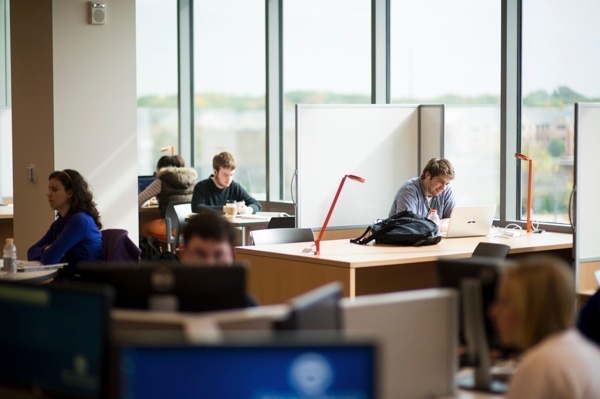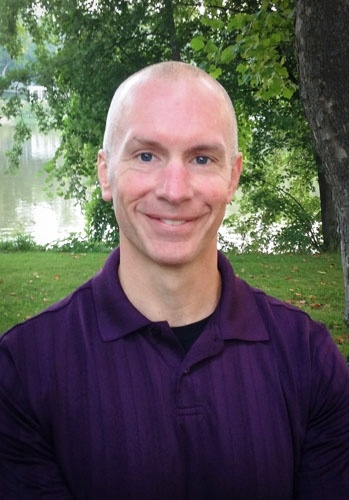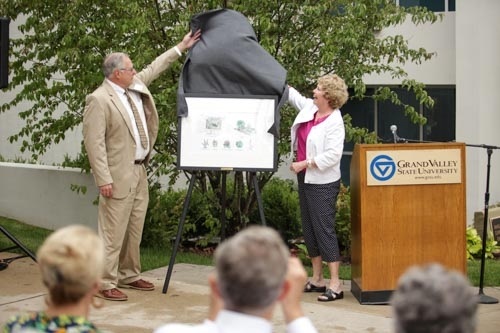Campus News Fall 2014
Library earns LEED Platinum status
The Mary Idema Pew Library Learning and Information Commons was awarded LEED Platinum status by the U.S. Green Building Council — the highest of four possible levels of certification.
As the first LEED Platinum library in Michigan, the facility demonstrates the university’s commitment to sustainable progress through innovative design and construction.
Planned to be the intellectual heart of the Allendale Campus, the facility was completed and dedicated in 2013. LEED certification is based on several factors, including site sustainability, water efficiency, energy use, materials and resources, environmental quality and innovation in design.

The Mary Idema Pew Library received LEED Platinum status, demonstrating the university’s commitment to sustainable progress through innovative design and construction.
With more than 154,000 square feet of space, the Mary Idema Pew Library is more than double the size of the former James H. Zumberge Library and has triple the seating capacity. The library boasts multiple customizable spaces for both quiet studying and collaborative work, more than 700,000 books, 1 million e-books, an abundance of natural lighting, outdoor work spaces and a Knowledge Marketplace where students can find academic support services.
New director of MAREC named

Kevin Ricco
Kevin Ricco was named the new director of Grand Valley’s Michigan Alternative and Renewable Energy Center. He succeeds T. Arnold Boezaart, who retired at the end of October after serving as director since 2009.
Since November of 2012, Ricco has served as manager of operations for Grand Valley’s Pew Grand Rapids Campus and Regional Centers. Prior to that, he was Allegan County’s first director of county development where his responsibilities included economic development, Brownfield redevelopment, and parks and recreation and tourism management.
“Kevin’s collaborative leadership style will enable MAREC to enhance its mission as a catalyst for economic development as well as a research and development center,” said Brian Copeland, associate vice president for Business and Finance. “We’re grateful for Arn’s leadership. He effectively opened the doors of the MAREC facility to the community and led the way in business development and many research activities.”
Ricco said his plans for MAREC include continuing to build the business incubator program and weaving in Grand Valley’s academic mission into the center’s work, “whether that’s connecting students with our incubator clients or planting seeds that might spark some interest and focus on entrepreneurial enterprises among our faculty and students,” he said.
He said Boezaart has done a tremendous job of building community relations in Muskegon and surrounding communities. “I would like to continue to build relations and get to a point where MAREC is the first thing that comes to mind when people in the state, region and even country think of alternative and renewable energy,” Ricco said. “Clean and renewable energy resources are becoming vitally important, and technology is a big part of this movement. I look forward to helping facilitate this endeavor.”
Children's Enrichment Center gets four-star rating
Grand Valley’s Children’s Enrichment Center has been awarded four stars by Great Start to Quality, through the Michigan Department of Education. It is Michigan’s first rating and improvement system for early learning and care.
Programs and providers can earn between one and five stars, based on the number of state standards they meet. The stars rating system started in 2012 and is based on five categories, including staff qualifications, family/community engagement, management, learning environment and curriculum.
About one-third of all licensed child care providers are participating in the program, which is implemented by Early Childhood Investment Corp., a nonprofit organization.
The 42-year-old center provides early care and education for children of student parents, faculty and staff members, and community members. Learn more at www.gvsu.edu/child or www.greatstartconnect.org.
Enrollment tops 25,000, includes largest first-year class
Students have enrolled in record numbers at Grand Valley this fall. The campus welcomed a record number of first-year students at 4,226, bringing the total number of students to 25,094, hitting a major milestone for the university.
The percentage of minority students is also a record high 15.6 percent; there is a record number of international students, with more than 400 enrolled; and a record number of out-of-state students enrolled, 1,384. There’s also an increase of students from southeast Michigan.

Pictured is Campus Life Night, an annual event that draws thousands of students. Enrollment at Grand Valley surpassed 25,000.
“What these numbers represent is that Grand Valley is true to its commitment to students,” President Thomas J. Haas said. “We want controlled growth so we can ensure quality programs and smaller class sizes. We also have a keen eye on what our students need to be successful in pursuing careers or advanced degrees. Our academic programs, with our liberal education base, are relevant to the region and the world.”
Haas also said that the university’s ability to control cost is critical for students and is strengthened by steady and generous supporters. Grand Valley is on the list of “America’s Best College Buys” for the 19th year in a row. The Grand Finish grant encourages students to stay on track to graduate in four years with a $1,000 scholarship given at the start of the fourth year to students with 90 credits. The net cost of tuition at Grand Valley actually decreased this academic year because of an increase in financial aid and a tuition increase of less than $300 per year.
David S. Hooker, chair of the Board of Trustees, said the board is committed to making sure that qualified students have access to a Grand Valley degree, and that the degree signifies a well-educated graduate. “We are confident in the financial responsibility of the university, and the number of students flocking to Grand Valley shows us we’re delivering in the classrooms and in campus life as well,” Hooker said. “I’m also pleased to note that the ambitious prediction of founding board chair Bill Seidman, that one day Grand Valley would be home to 25,000 students, has been realized.”
Enrollment increases in engineering, health professions, nursing and business show how closely the university’s programs align with students’ desires and employers’ needs.
Provost Gayle R. Davis said faculty members work hard to support students as they earn diplomas. “Our faculty are designing programs that help Grand Valley students become life-long learners and contributors to their communities as well as secure, suitable employment upon graduation,” Davis said. “We’re thrilled with the quality and diversity of the students who are choosing Grand Valley.”
Grand Valley was rewarded by the state Legislature and the governor for a third year in a row with appropriations based on performance. Grand Valley has the third best graduation rate of all public universities in the state of Michigan, and is in the top four for retention rates. Grand Valley is a brain gain for the area with nearly 85 percent of Grand Valley graduates staying in Michigan to begin their careers or graduate work.
For full details on Grand Valley’s academic and financial accountability, see www.gvsu.edu/accountability.
Grand Valley joins Chevy to go green
Grand Valley is participating in a Chevrolet program to increase clean energy efforts and decrease carbon emissions.
As part of Chevrolet’s Campus Clean Energy Efficiency Campaign, Grand Valley commits to continue its efforts to reduce carbon dioxide from entering the atmosphere.
Grand Valley’s carbon reductions will be certified as voluntary carbon credits and Chevrolet will pay the university for its reductions and permanently retire them to benefit the climate.
Terry Pahl, facilities engineer, applied for the program and said using energy-efficient practices is part of the campus culture. To qualify for funding, Grand Valley had to demonstrate that its energy-based greenhouse gas reductions on a campus-wide basis surpassed the performance of the top 15 percent of campuses in the nation.
“A university is both chosen and evaluated based on either individual LEED certified buildings or a campus-wide energy efficiency performance,” said Pahl. “Grand Valley opted for the campus-wide performance program and is the only university in Michigan that has been chosen for Chevrolet’s program. The millions of dollars we save from energy efficiency improvements and the funds we’ll receive from Chevrolet allow us to reinvest in the university and our students.”
During the last 15 years, Grand Valley has implemented more than 250 energy-saving projects and procedures. By the end of this calendar year, Grand Valley will be avoiding energy costs of at least $2 million annually through the use of energy-efficient practices, procedures and technology.
Examples include various lighting projects, temperature setpoints and setbacks, building system infrastructure and energy education.
New initiative adds to areas design ecosystem
Grand Valley announced a new initiative that continues its commitment to ensure students will be prepared for lifelong learning and careers in an ever-changing society.
The Design Thinking Initiative is a human-centered approach to solving problems and meeting needs using an organized method of defining, observing and considering those impacted. Provost Gayle R. Davis announced that John Berry will lead this
initiative.
Berry is executive director and founder of Design West Michigan, a design advocacy organization with more than 1,100 members. He also served as vice president for corporate communications for Herman Miller.
Davis said Berry will lead the exploration of how to connect existing programs, classes and co-curricular activities with appropriate new ones, and collaborate with other creative and innovative organizations in the region.
Berry said he looks forward to establishing partnerships with organizations “that have an interest in expanding our design ecosystem. ”

John Berry
“Grand Valley’s initiative significantly adds to the design ecosystem of West Michigan, which is extremely robust with design talent,” Berry said. “Creating this initiative will allow students to gain additional experience with innovation and problem-solving that also will increase our regions’ ability to create and grow.”
Berry earned a master’s of fine arts degree from Cranbrook Academy of Art. He is a past board member of the Michigan Humanities Council, Ox-Bow Art and Artists School, Grand Rapids Art Museum, Kendall College of Art and Design. He is a current member of the National Advisory Committee for Cranbrook Academy of Art.
New garden dedicated
The Marilyn E. Zumberge Garden was dedicated in a ceremony outside of Zumberge Hall August 19.
Marilyn, wife of the late James Zumberge who was Grand Valley’s first president, served as first lady during their six years at the university from 1963-1969. Marilyn died in June 2008. The ceremony was attended by several family members, including the couple’s three sons: Mark, Jim and John.
Marcia Haas, current first lady, said: “It is fitting that Marilyn’s name graces this beautiful garden and building.
"The garden is designed to look beautiful in every season and captures her beautiful spirit and contributions to Grand Valley.”

John Zumberge and Marcia Haas unveil a rendering of the garden.
photo by Adam Bird
John Zumberge spoke on behalf of the family. “This is so special for us. It is exciting to see the growth of this whole campus,” he said. “My mother loved gardens, both formal and wild. She would have approved of this garden.”
